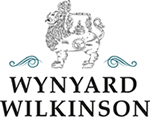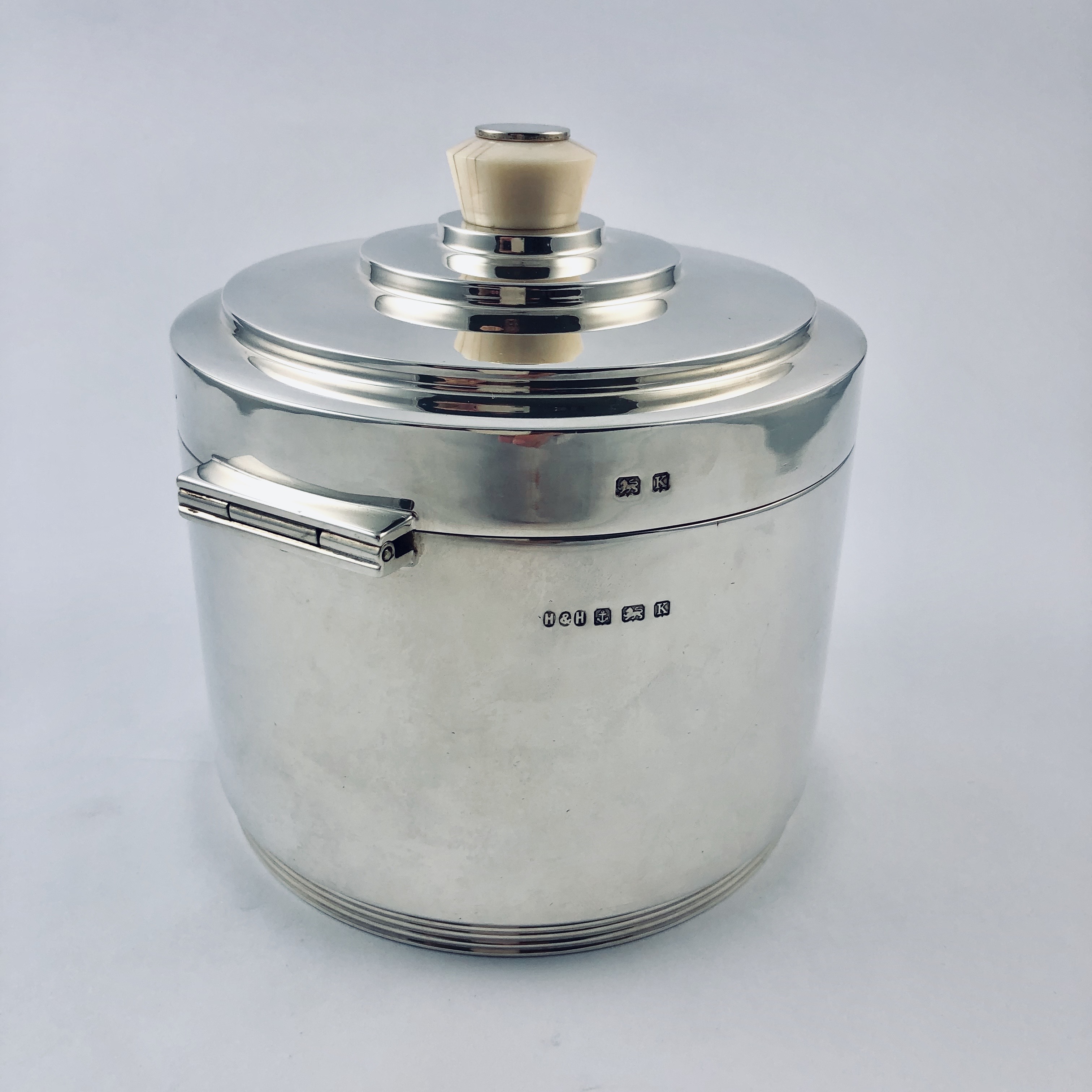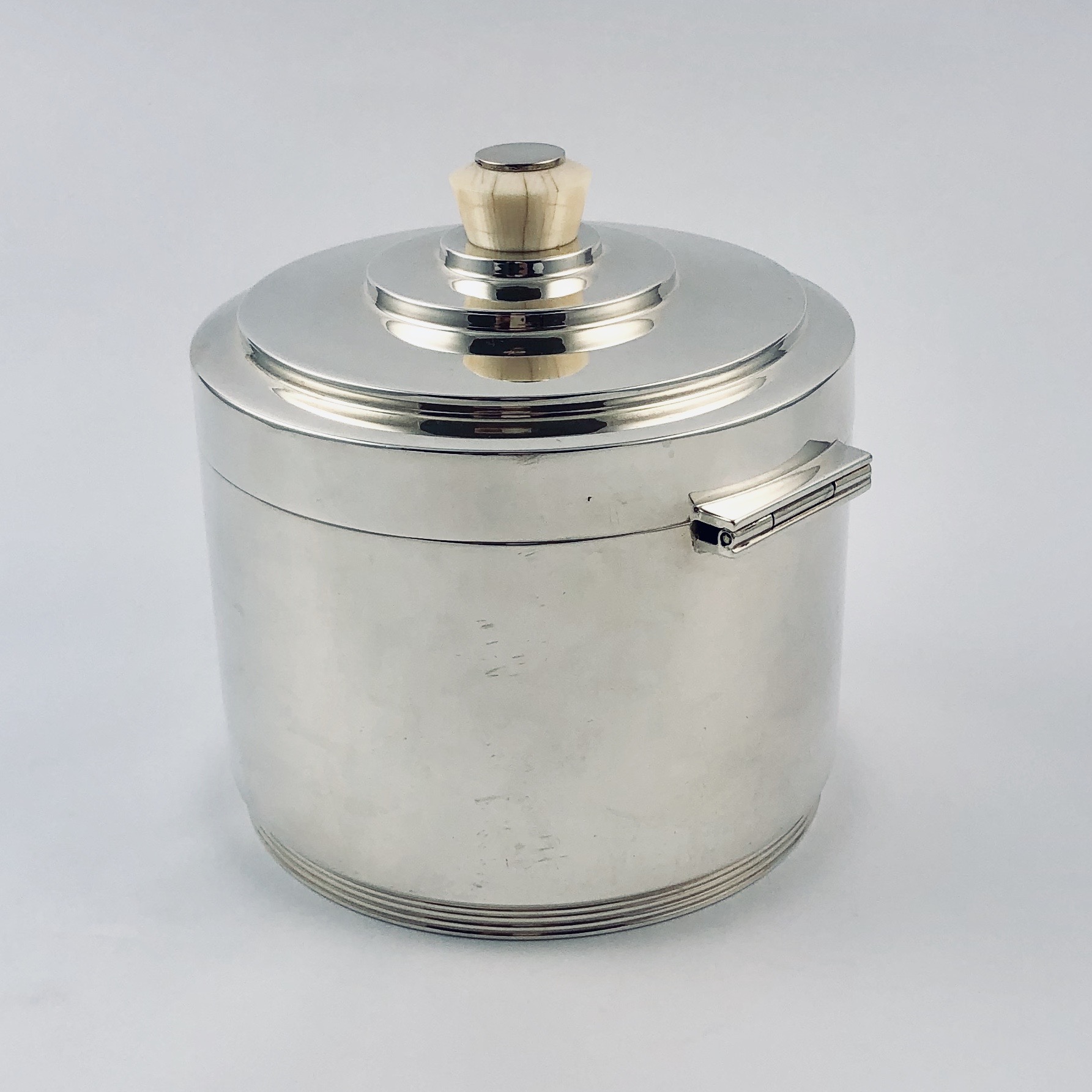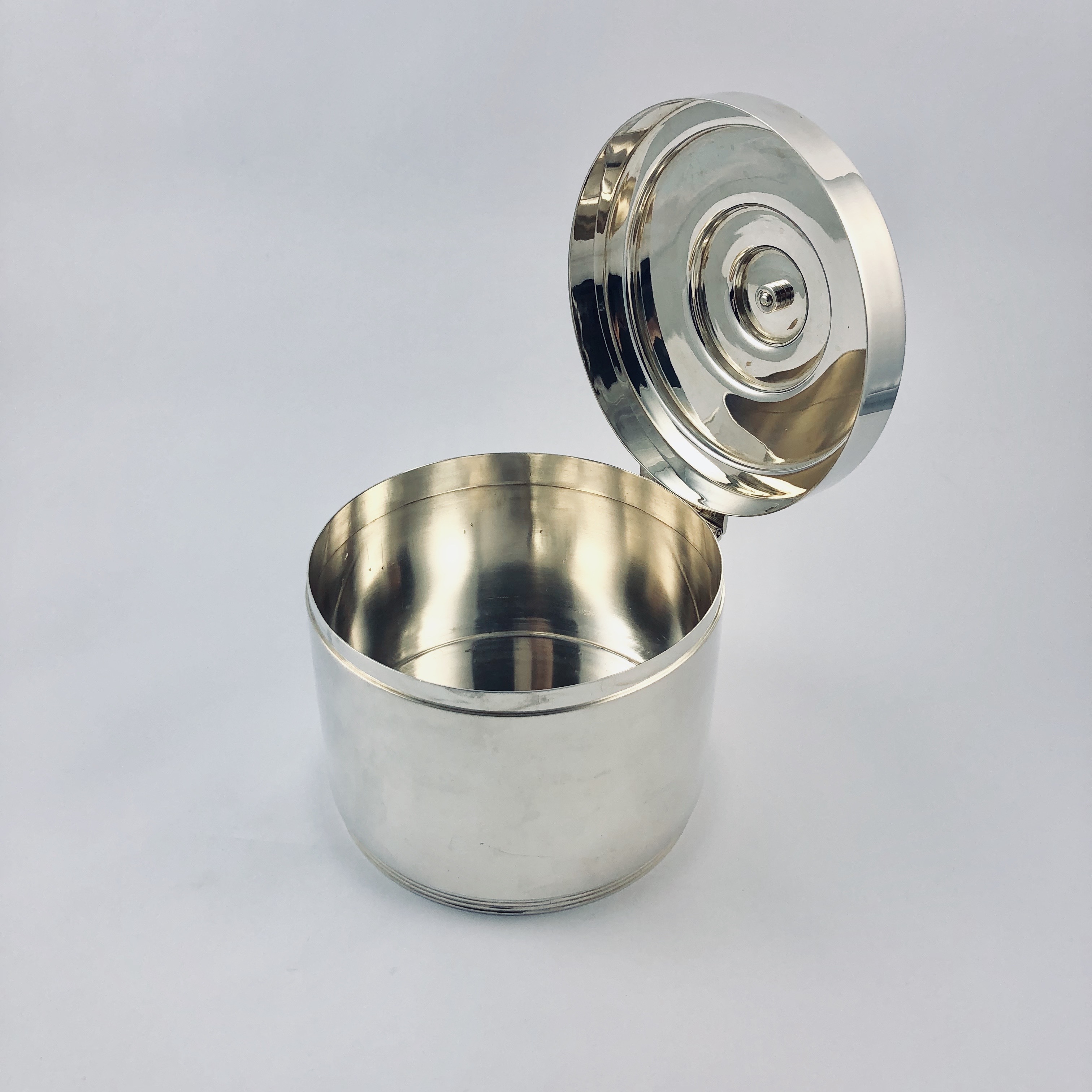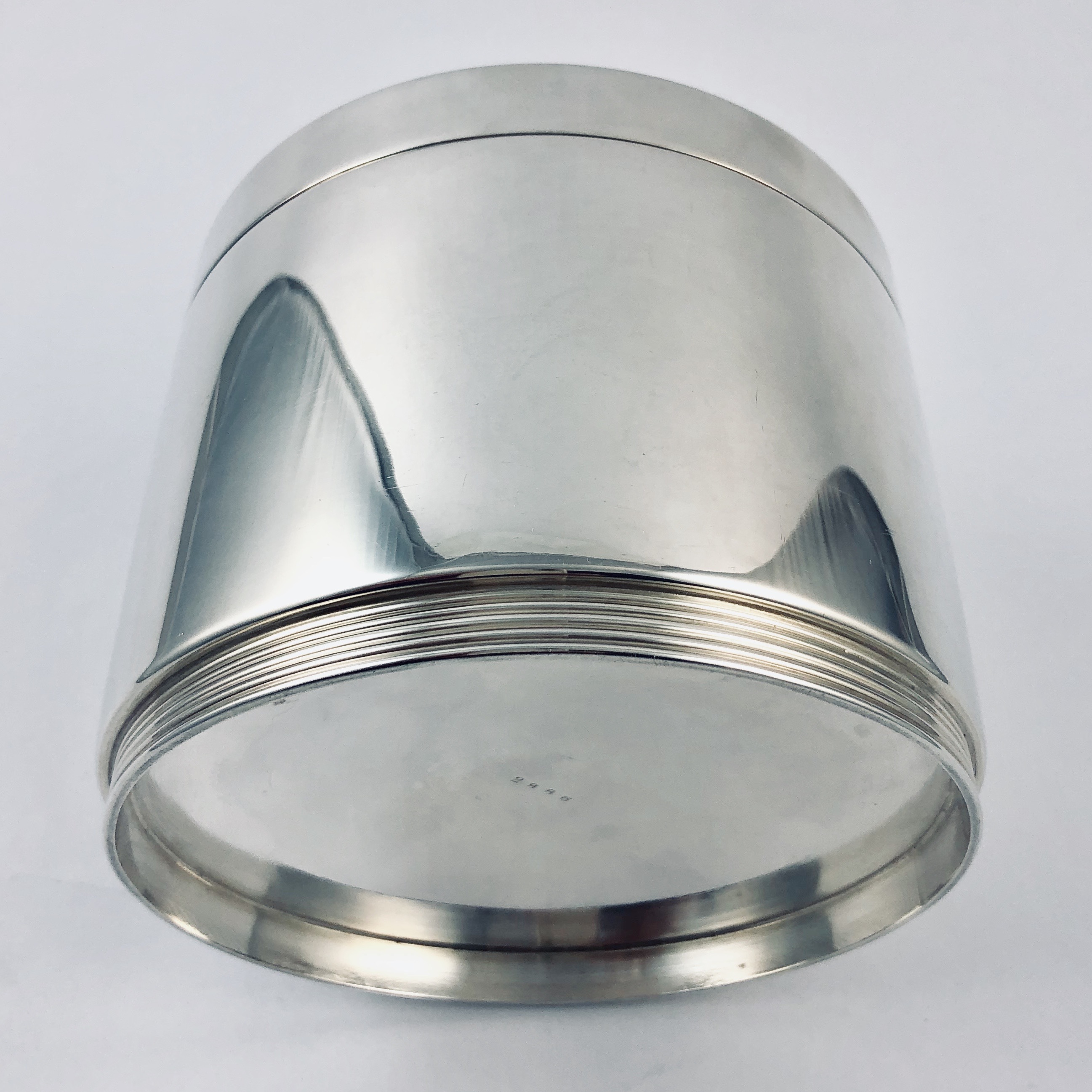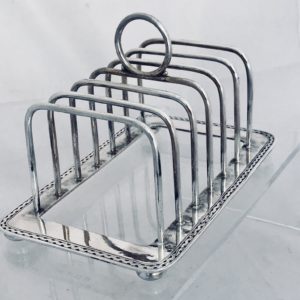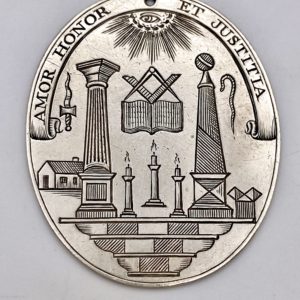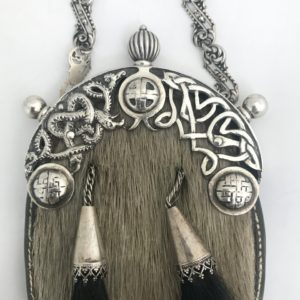Description
An Art Deco sterling silver biscuit box of right circular cylindrical form with inset protruding flange at the top (to receive the hinged lid over it), a flat base with a slightly inset, circumferential, reeded wire foot and a close-fitting, hinged, circular lid with three slightly domed concentric circular steps, of four plains of varying width, to an inverted conical section finial secured to the lid with a threaded pin and nut, the pin being capped with a circular disc. The box and lid are of sterling silver with surfaces undecorated. The finial securing pin and nut are also sterling silver.
Hallmarks:
Box: maker’s mark of plain capitals ‘H & H’, each separated in an oval punch, for Hukin & Heath Ltd.; Anchor (Birmingham); Lion Passant (Sterling); upper case roman ‘K’ (1934-5).
Lid: Lion Passant; upper case roman ‘K’. Finial securing pin and nut: Lion Passant.
Dimensions & Weight:
Box (body and lid dia.): 13.1 cm / 5 3/16in.; Height (with lid/finial): 13.7 cm / 5 3/8in.; Gross Weight: 730 gm / 23.5 ozT
Design No: The underside of the box carries design re-order no. 2886.
A similar piece, a silver tea-caddy with knop, designed by A.E.Harvey and made by Hukin & Heath, is illustrated in British Design since 1880, Fiona MacCarthy, 1982.
Of the 20 examples of Harvey’s designs included in the 1935 Royal Academy Exhibition of British Art and Industry, one was a silver biscuit box, made by Hukin & Heath Ltd, and retailing for £11 5s.
A. E. Harvey
Born 22 Oct 1893, the son of a cycle manufacturer, he died 13 Sep 1978. For a timeline of his life, based on notes made from files held at the Royal College of Art in 2019, see Appendix at the end of these notes. Some other sources refer to an early education in Paris, Dijon and Vienna. However, we have as yet found no evidence of this.
By 1906 the family had settled in Enfield, Middlesex, where his father was working as a gun finisher in the Royal Small Arms factory. In the 1911 census, Arthur is described as “Designer and Modeller, pewter and lead work”, as is his younger brother Horace Clarence Harvey (born 1894). Both saw service in the Royal Naval Volunteer Reserve, signing up on the same day, with Arthur’s service record, dating from 29 Sep 1917, showing his prior occupation as ‘architect and decorator’. He is referred to as ‘architect and industrial designer’ in a letter of 7 April 1920 accompanying a Wm. Morris & Co. catalogue [Modern First Editions, Ilkley], and yet further evidence lies in the index of Royal Academy Exhibitors, 1905-1970, in which his work as an architect is exhibited in 1916, -18 and -19, then later in 1927.
Further clues to his early education/career appear in notes on the V&A website against two of his pieces in their collection: “A.E. Harvey, architect and industrial designer, received his original training as an artist at the Royal College of Art, the Slade School and Royal Academy School.”
His registration at the Royal College of Art (RCA) for the Modelling and Design course leading to an ARCA Diploma is recorded on 7 Jan 1919, as is his graduation in 1921 and 1923, with final departure from the RCA on 17 Jul 1925. Interestingly, younger brother Horace registered for the ARCA Diploma/Design course one week after Arthur, leaving the College in July 1922 and graduating in 1923.
While at the RCA, Arthur also studied part-time, 3 days per week, at the Slade School in the 1921-22 and 1922-23 sessions, entering on 21 Feb 1922 (the second term) and undertaking one month of Life Drawing, then completing the third term of that session. He studied Fine Art in the first term of the next session but left in Dec 1922 having not been a candidate for the Fine Art Diploma. However, recommended by Charles Leonard Hartwell A.R.A., Arthur quickly moved on, aged 29, to the Sculpture School of the Royal Academy on 12 Mar 1923. While at the Slade and Royal Academy Schools, he lived at 14 Kensington Studios, Kelso Place W8, though Enfield was his home address until at least 1925 when he moved to Birmingham.
Fiona Waterhouse, Research Assistant at BCU Arts, Design & Media Archives, notes that, “Our records show that he was first appointed to teach painting and drawing at Birmingham School of Art in 1925.” Following marriage in 1928, “in 1930, his role changed in that he was transferred to the teaching of Trade Draughtsmanship and Design. He became head of department in 1933, and appears to have stayed there until 1956.” Sadly, his younger brother Horace, who had developed a successful career as teacher of Archaeology and Vice Principal of the Art School in Southampton, was killed in an air raid during 1940.
Further references to Harvey’s training and formation as a designer are provided by Michael Farr in Design in British Industry, 1955, who says: “There were designs for English silverware that approached the purism of the Bauhaus but on the whole these were conceived by designers who were not primarily silversmiths themselves. A.E. Harvey trained as an architect, practiced as an industrial designer and later became head of Industrial Design at the Birmingham School of Art. His work is characterised by plain shapes, only alleviated by simple ridged mouldings which could easily be produced by machine.” He goes on to note, in a section on the Birmingham School:
Similarly, Dennis Farr, in English Art 1870-1940, observes that: “It is significant that the most radical designs were made by the head of the School of Industrial Design at Birmingham, A. E. Harvey, who … had no links with the craft traditions.”
Some 20 examples of Harvey’s design for domestic silver and plated wares were included in the 1935 Royal Academy Exhibition of British Art and Industry.
Soon afterwards, on 13 Feb 1936, he was made Free of the Worshipful Company of Goldsmiths, acknowledged by the Victoria & Albert Museum when describing his pieces in their own collection: “As Head of the School of Industrial Design at Birmingham School of Art, he was made a Freeman of the Worshipful Company of Goldsmiths’ (London) for his contribution to its improvement of design schemes.” [V&A website]
The 1939 Census lists him as, “Department Head, School of Industrial Design, Birmingham Central School of Art”, recording him in Chipping Campden – but, in the nature of the Census, this might only be as a visitor. It is tempting to think there might be a connection here to the Harts and the Guild of Handicraft…
Harvey’s standing is acknowledged again by the Victoria & Albert Museum who say that, “A. E. Harvey together with Harold Stabler and Keith Murray, was amongst the first of the designers to produce designs for mass production. Domestic silver in a contemporary modernist style was made to order for the Goldsmiths’ and Silversmiths’ Company Ltd. and Mappin and Webb Ltd. and produced in the factories of Hukin and Heath Ltd. and Deakin and Francis Ltd.” [V&A website].
This is borne out by an entry in the catalogue for the 1965 exhibition, ‘The Worshipful Company of Goldsmiths as patrons of their craft, 1919-1953’, which notes that “A.E. Harvey was head of the design department at the Birmingham College of Art and designed a number of simpler things that could be produced inexpensively both in silver, electro plate and fancy goods. Most of his silver work was made up by Hukin & Heath and Deakin & Francis, both Birmingham manufacturers, who helped in the Plate Improvement Schemes. He was encouraged by H.H. Holden, Principal of the College, to whom the Freedom and Livery of the Company were awarded in recognition of his work for the Company.” There are six pieces designed by A.E. Harvey in the collection of the Worshipful Company of Goldsmiths’, dated between 1929 and 1936, marked by various makers: Mappin & Webb (Birmingham), Hukin & Heath (Birmingham) and Goldsmiths’ & Silversmiths’ Co. (London).
Harvey’s work appeared and is illustrated in the catalogues of the following exhibitions:
- British Art in Industry, Royal Academy 1935
- Birmingham Gold and Silver 1773-1973 (1973)
- The Worshipful Company of Goldsmiths as patrons of their craft, 1919-1953 (1965)
- Finely Taught, Finely Wrought, The Birmingham School of Jewellers and Silversmiths 1890-1990 (1990)
- Treasures of the 20thCentury, The Goldsmiths’ Company (2000)
APPENDIX
A.E. Harvey Notes from file at the Royal College of Art (2019)
1906 – comes to London with his family when his Father gets job at the Enfield factory.
1906-1909 – Enfield Senior Schools
1909-1913 – Birkbeck College
1909-1914 – (While studying) – works as a pupil with George P. Bankart.
1913-1915 – St Martins School of Art; also
1914-1915 – Edinburgh School of Art
1914-1915 – Works with the Tynecastle Co.
1915 – Works with Cashmere & Co.
Oct 1915 – As the result of a £120 p.a. (Three year) scholarship won from the L.C.C. (London County Council) for an exhibit (never named) in Enfield, enrolls at the RCA. Described as a ‘Designer & Craftsman” when he joins.
Nov 1915 – Removed by the Visitor* from RCA Upper School to Upper Division. [* The Government’s Board (later Ministry) of Education’s most powerful influence on the College was through the College Council for Advice on Art, and its Board of Visitors, who acted as inspectors / external examiners. The Visitors were appointed ad hoc but from 1909 were appointed annually. They visited the College only at the end of each term, to report on the College, to set tests for the students, and to award diplomas.]
Oct 1916 – RCA Report: A gifted and excellent student. His work in draughtsmanship and design is of high order and promise.
Oct 1917 – Volunteers and is assigned to Gun Station RNVR AAC (No. AA2829)
7 Jan 1919 – Rejoins RCA to continue studies, with scholarship topped up by The Army (Ex Service Mess Grant).
1921 – Teaching three evenings a week at Wimbledon School of Art and working as a designer and craftsman for manufacturers, private individuals etc.
2 Jan 1925 – Rejoins RCA to study for Teaching Diploma, which he gets.
26 Jan 1926 – Full time master at Birmingham Central School of Arts & Crafts, teaching Industrial design, Trade draughtsmanship and perspective.
1926 – Writes to RCA for return of a carved, gilded and coloured heraldic panel, which he lent them for the Paris Exhibition.
1 Sep 1927 – The British Institute of Industrial Art invite AEH to send some of his pottery to the exhibit at the V&A Museum. AEH wants to send his “Crucifixion” that is hanging in the pottery school at the RCA.
